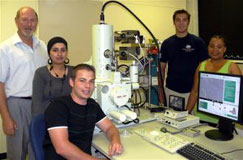Science and technology
R80m microscope boost for nanoscience
Nanotechnology, nanomedicine
In 2007, South Africa launched two new innovation centres to help the country compete globally in the fast-developing fields of nanoscience and nanotechnology, which studies matter and its applications on the atomic and molecular scale. The National Centre for Nano-Structured Materials is based at the Council for Scientific and Industrial Research (CSIR) campus in Pretoria, while the Department of Science and Technology/Mintek Nanotechnology Innovation Centre is based in Johannesburg. Among nanotechnology's list of possibilities is the potential to dramatically improve the condition of the world's poorest people. Nanotechnology inventions can help improve food production, and provide clean water, cleaner energy sources and cheaper transport of goods to people in remote areas. They can also help combat disease: the applications of nanomedicine for improving therapies against malaria, tuberculosis and HIV/Aids have only recently begun to be explored.Nano-encapsulated drug delivery system
Researchers at the CSIR are heading up the development of a new nanomedicine drug delivery system that aims to improve the current inadequate therapeutic management of TB. They have successfully nano-encapsulated four first-line anti-TB drugs into polymeric nano-particles, using a technology the CSIR has now patented. According to Dr Hulda Swai, head of the CSIR's nanomedicine platform, the nano-encapsulated drugs are slowly released over six days while maintaining the minimum inhibitory concentration; are not toxic to cells; and when administered to TB-infected mice once weekly, show comparable efficacy to equal doses of free drugs administered daily. Speaking at Sunday's workshop, Pandor congratulated the CSIR on its work. "With the project now in clinical trials, prospects for success look good," the minister said. "A lot of capability has been built in the area of drug-delivery systems using nanotechnology," Pandor said, adding that the technology could be applied to a range of other drugs. SAinfo reporter and BuaNews
Nelson Mandela Metropolitan University physics professor Jan Neethling and some of his postgraduate students with one of the smaller, companion instruments of the high-resolution electron microscope (Photo: Nelson Mandela Metropolitan University)
Related links
Related articles
- SA-based scientist in world top 100
- Google launches Africa tech incubator
- South Africa's SKA bid 'firmly on track'
- US govt contract for SA medical isotopes
- R&D; spending up, still short of target
- SA university showcases hydrogen bike
- 'Tea bag' filter delivers purified water
- CSIR laser technology a 'world first'
- Easier TB treatment 'one step closer'
- SA scientists win AU awards
- Gates grant for TB researcher




